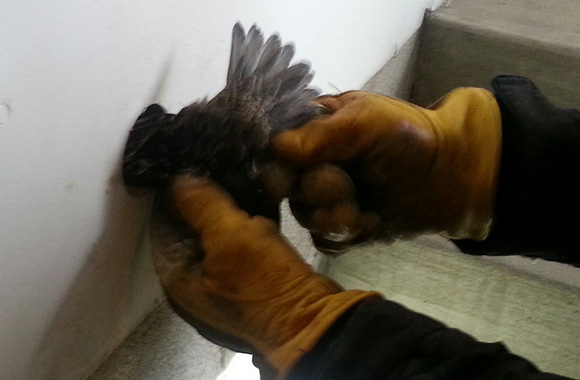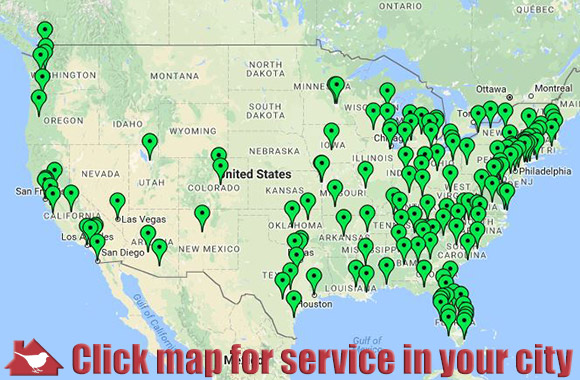How to get birds out of a wall
Birds are everywhere in the world. As man expands his domain, we destroy their natural nesting grounds, causing the birds to adapt and find new places to raise their young. Barns, sheds, garages, warehouses, and even your home can be a tempting nesting spot for our feathered friends. It is sheltered from the elements, easily defended from predators, and has access to food and water. A bird taking up residence in your home can be a serious problem. In many places certain species of birds are protected, and cannot be removed if they have eggs or hatchlings until the young are old enough to leave on their own.
First, confirm that your infestation is indeed birds. Actual Visual confirmation is always the best way, but another sign will be loud chirping or squawking sounds that start around dawn and continue throughout the day. Birds leave to search for food in the morning and continue back and forth all day, whereas rats, squirrels and mice will wake up at dusk, and run around inside your walls. If you do have a problem with birds and believe that they have infiltrated your walls, getting rid of them is time consuming, but entirely possible. The struggle is not just to get them to leave for good, but to keep birds from becoming trapped inside your walls and dying there.
Start by inspecting your walls for cracks, fissures, or holes that could allow birds entry. These can be accessible from the outside, or from your attic. Birds can fit through very small spaces, so just a few inches can serve as a doorway. Your chimney, as well as Central air vents, window sashes, and eaves can allow for access to birds. You can quickly identify the entry ways by the excessive amount of droppings left behind. Rats, mice, and squirrels will leave hard, dark, rice shaped pellets. Bats will leave dark oily marks. Once you have identified their bird “portals” watch to see what times they leave the nest. Birds will begin to exit sometime around dawn to find food, and continue throughout the day.
Often a male and female will both tend the young and are not always gone at the same time. Watch for this as well. Once you have a good idea of their exit times, and you can confirm that no birds or hatchlings have been left behind; you are ready to lock them out! While it is not absolutely necessary, it is recommended that you spray the area with a commercial bird repellent. There are a number of varieties on the market today. Many professionals will tell you that a dog or cat repellent will work just as effectively. When applying any repellent, try to spray it just inside the walls and around the affected areas.
If the repellent causes an adverse reaction in birds, other animals including your pets or family could be affected as well. Once you have sprayed following any directions included with the repellents, completely seal any and all openings that you found around your home. Block the openings whether or not the show signs of use by birds. Once you have blocked all entryways and are sure that your birds cannot get back in, they will find another place to nest. They may attempt re-entry for 3-5 days, but if you have properly sealed all holes, they will give up and go in search of other shelter. Once you are clear, you need to go in with lights and double check that no eggs or hatchlings where left behind. If young were left, you should be able to hear them call for their parents. If you do find eggs or young, you must retrieve and dispose of them quickly. You do not want rotten eggs or dead hatchling carcasses in your wall. Besides the obvious stench, the will attract bugs and other carrion eaters into your home. This will cause you a whole other costly and time consuming problem.
To avoid another bird infestation, take preventative measures. Properly inspect and maintain the exterior of your home. Look for damages to the eaves, roofline, and windows. Put up bird block in soffits, and screen over chimneys and vents. Keep grass, shrubs, and bushes trimmed and get rid of standing water sources. If birds are predominate in your area, consider putting up a bird houses around your yard offer them an alternative nesting area. Birds can be quite beneficial as they eat large amounts of pests like ants, mosquitoes, fleas, ticks, spiders, and more.
If your bird problem is too much for you to handle on your own, don’t think that you just have to live with it. You can contact a professional animal control service who will gladly come and handle it. Not only will they get rid of birds efficiently and safely, the will dispose/ relocate and eggs or young. They will also be up to date on any laws concerning your particular species of bird.
Other thoughts on how to get pigeons out of a wall: The way I look at it, you have four options when it comes to getting pigeons out of your wall. The easiest method is to hire in a guy like me who’s been doing a job like that for many years and has the tools and experience to get the job done quickly and efficiently. The second option is to try and use repellents to get rid of the birds before realizing that they are a pointless exercise and instead resort to method number three … trapping. This is a very bad and pointless option because pigeons are ‘homing’ animals which means they’ll always find their way back home (probably before you do) regardless of how far away you release them after you’ve trapped them. It’s illegal in most states to shoot a pigeon on your land so that’s method four out the window. Poison rarely works and creates more problems than it solves so that’s number five vetoed. Exclusion is your one final optiona manual option as suchthat requires you to seal the holes, repair the damage, exclude the animals using specially bought (or created) equipment, and then ensuring your repair work stands the test of time. Essentially method one would have been quicker, cheaper and by far the best option right from the beginning!

When birds get stuck in a wall, it is down to you to try and retrieve them. If you leave them, they will die. When that happens, they will decompose, create a bad stench, and attract flies and other wildlife.
You often have just three options when it comes to getting animals, including birds, out of a wall. You can sometimes reach it from the top, via the attic. You might be able to reach it from the bottom, via crawl spaces. And if both of those methods fail, you will probably need to physically cut out a portion of the wall, remove the bird(s) and then repair the wall. The latter is frequently the case more often than you’d think.
You are going to want to make sure that you are cutting the right place. This is not a procedure to repeat multiple times, unless you want multiple cut-out holes in your wall. You should use your nose and your sense of hearing to pinpoint exactly. Where the birds are. They will scuffle and chirp when they are still alive, especially if there are young chicks in a nest. If they have already died, you will likely start to smell them within a couple of days.



